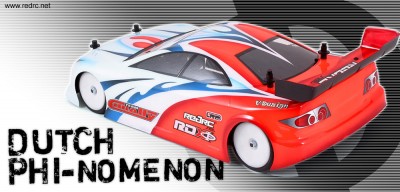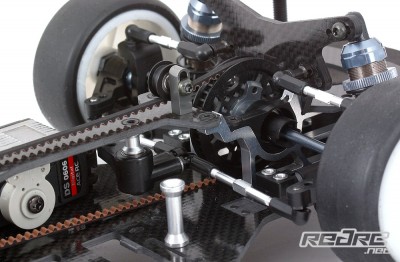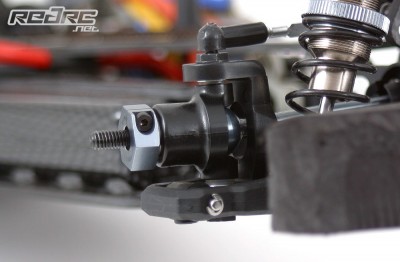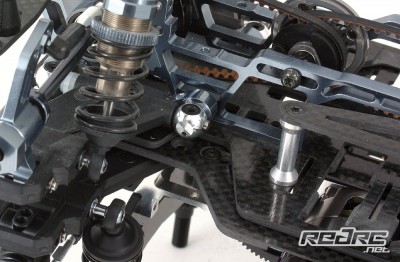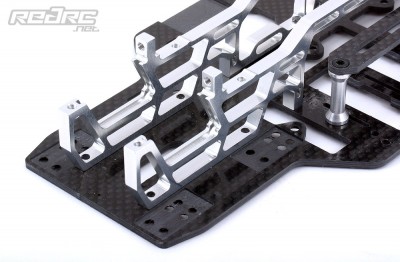Dutch Phi-nomenon – Corally RDX Phi 09
Seen for the first time at the annual DHI-Cup in Denmark the 2009 Corally RDX Phi is finally here. Based on the successful RDX Phi platform the ‘09’ tourer offers the same versatile layout the previous car did but is specially designed to accommodate the ‘bulky’ LiPo hardcase batteries that are becoming more common these days in various racing classes. Most noticeable are the newly designed and higher bulkheads, new suspension mounts and last but not least a wider chassis plate. What else has the new Corally RDX Phi 09 to offer? We will find out in our review.
Front
Those who are familiar with the Phi range of cars will instantly notice the differences between the previous RDX Phi and the 09 version. First up, the 09 sports taller bulkheads to raise the topdeck by around 7 mm to make way for hardcase LiPo battery packs and power cables. The next and probably more important change are the new suspension mounts that do away with the complex clamp and pivot ball assembly and substitute it for a more user friendly plastic block/pivot ball construction. Kick-up and toe settings are adjustable via shims/different blocks but these are not part of the kit and therefore have to be bought as option parts. Compared to the ‘older’ Phi the 09 model has 1.5 degrees of toe-out with the supplied wishbone mounts whereas the predecessor had 0 degrees. In theory the 1.5 degrees toe-out setting should scrub a bit more speed when going into corners.
New on the 09 version of the Phi TC are updated ‘narrow’ (#79630) plastic steering blocks. They are less beefy than the usual #79280 ones and offer two inline holes for the steering ballstuds rather than side-by-side ones as found on the #280. Also new to the Phi 09 are plastic 3 degree caster blocks that replace the aluminium ones (Please see also our ‘Performance Tips’ section at the end of this review). Unchanged from the older car is the front one-way differential that is an ideal setting for fast to medium (outdoor) tracks. Optionally a lightweight Delrin spool, an aluminium spool or a ball differential can be fitted. On a side note: we tested the #01620 ‘Euro’ version of the RDX Phi 09. A special ‘US Carpet Spec’ edition (#01621) with thicker chassis, harder springs, different C-hubs and a front differential is also available for those who want to experience the mayhem of running touring cars with foam tires on tight US style carpet tracks.
Back to the euro car. Front geometry is changed in terms of toe settings but also the shock stay has undergone a bit of an evolution, now showing four instead of three mounting holes for the oil filled shocks. The holes now sit closer together allowing for an even finer tuning of the set-up. Even the mounting holes for the upper camber links have undergone a bit of modding as they also sit a bit closer together and went a couple of millimetres towards the outside to make for overall shorter upper links giving the chassis less roll in corners. Just behind the front one-way the new centre point steering assembly is located. The previous Phi offered this set-up too but the 09 car now sports a plastic lever instead of an aluminium one and also has horizontally mounted steering link balls to fine-tune the steering characteristics.
Middle
Corally’s new RDX Phi sports a 2.4 mm carbon fibre chassis that has undergone a huge evolution compared to the previous car. The new chassis plate is around 10 mm wider on the widest part and now has a ‘full surface’ design underneath the wishbones. Where the old car had 70 mm wide ‘ears’ for the droop screws the new plate has gotten rid of these ears/wings by having material remain in front and behind the wishbones. This is because the new pivot mounts for the wishbones attach here.
When looking at the chassis plate one could see that the 09 version still shows loads of countersunk screw holes to add brass weights, change wheelbase settings or add different battery mounts but the new plate does away with the square holes for the old design Corally brass weights and made way for the new style brick design ones. They are also meant to ‘only’ mount behind and beside the battery pack instead all the way along the centre line of the chassis as seen on the older Phi. The locating holes in the 09 chassis plate show what’s important when using LiPo batteries: to get the weight towards the centre line of the chassis and especially towards the rear, as the cars might be too light around the back.
The design of the rear bulkheads is quite similar to the previous car but is adapted to raise the top-deck. Again the fixed layshaft construction is used having been introduced with the original RDX range of cars. The layshaft slides in a slotted hole each side of the bulkhead to make for an easy change of different front and rear belts to accommodate different sized pulleys that can be used to alter the internal ratio, which may be helpful if you want to race the car in stock classes. Corally offer a wide range of pulley and belts and the manual refers to all parts needed to do the mods. The supplied 78T 48dp spur gear is sandwiched between the aluminium centre hub and a aluminium support ring for a true running gear and minimal transmission losses. Standard with the standard Phi 09 are 21T centre pulleys and 42T one-way/differential pulleys.
